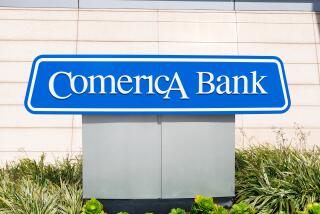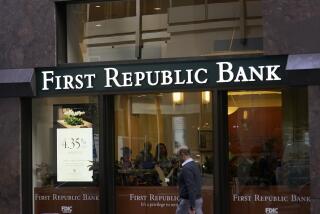40% of Big S&Ls; Fall Shy of Capital Standards
Almost 40% of the country’s 300 largest thrifts failed to meet minimum regulatory capital requirements at the end of last year, according to a survey by American Banker, the trade paper.
Experts say this means the thrift industry is still a long way from returning to health.
“The rich will get richer and everyone is scheduled for euthanasia--with pain,” said Richard Pratt, chairman of Merrill Lynch Mortgage Capital and a former chairman of the Federal Home Loan Bank Board.
The survey found that 239 of the top 300 thrifts at the end of 1989 were members of the Savings Assn. Insurance Fund. Almost half these institutions did not have the minimum of $3 of “core capital” for every $100 of assets, as required by federal regulations. In fact, 62 had negative core capital. A thrift’s capital is the cash it must have to serve as a cushion for any problems. It is normally measured as a percentage of its total loan portfolio and other assets.
The survey included 61 thrifts that were members of the Bank Insurance Fund. Virtually all of them had capital ratios exceeding 3%. The Bank Insurance Fund historically has mandated tougher capital requirements.
“It is safe to predict more seizures the remainder of the year,” said industry expert John Lyons.
Of the 2,878 Savings Assn.-insured thrifts in the country, about 600 more will disappear over the next few years, predicted Henry Peltz, thrift analyst at Keefe, Bruyette & Woods Inc.
“It is going to be very difficult for these undercapitalized thrifts to meet the capital guidelines,” he said. “The opportunity to raise capital in the public markets is extremely limited.”
Although many thrifts are restructuring and struggling to meet the new capital rules, Peltz noted, “The capital requirements are only going to get stiffer between now and 1994.”
For some thrifts, it is already too late. Thirty-five of the top 300 thrifts have been seized by regulators and are wards of the Resolution Trust Corp., a federal agency created to dispose of assets of thrifts taken over by the government.
The survey found that total deposits of the top 300 thrifts fell 1.9% last year, while their assets declined 6.4%. Peltz says shedding assets was “difficult in this market because others are also downsizing, so the prices you get for assets are not good.”
The core capital ratios in the survey ranged from a high of 22.1% for Citicorp Savings Bank of Washington, D.C., to a negative 122% for Sandia Federal Savings & Loan Assn. of Albuquerque, N.M. Sandia Federal was seized by federal regulators early last year.
Citicorp Savings of Washington is one of four thrifts owned by Citicorp, the nation’s largest banking company. Citicorp’s Illinois and Florida thrifts had core capital ratios of 15.6% and 13.8% respectively, ranking them second and third in this category.
Great American Bank, San Diego, typifies the problems faced by many of the undercapitalized thrifts. After a $263.4-million loss in 1989, Great American lost an additional $1.2 million in the first quarter of this year. Most of the losses were caused by problem loans in Texas and Arizona.
Great American’s capital plan calls for it to raise $350 million in new capital. Analysts say its chances of doing so are slim. The company is shopping for a merger partner or a cash infusion and is trying to shed assets, including its real estate development company.
Assets at California Federal Bank dropped about $2.6 billion in 1989. The Los Angeles thrift last year sold more than $900 million in mortgage-backed securities, its credit card portfolio and its headquarters building.
Officials said these moves were an attempt to raise additional capital, while also shrinking assets to fit CalFed’s capital base.
Coast Savings & Loan Assn. in Los Angeles undertook a major financial restructuring in 1989 to strengthen capital. The company eliminated $242 million of goodwill and exchanged debt for equity. It also lopped off $1.6 billion from its loan portfolio.
The American Banker core capital ratio uses total assets instead of tangible assets, which are total assets minus deferrals and intangible assets. For most of the thrifts listed, the American Banker ratio will be 0.05 to 0.15 percentage points lower than the ratio calculated by the Office of Thrift Supervision.
MORE THRIFT INDUSTRY NEWS, D2
More to Read
Inside the business of entertainment
The Wide Shot brings you news, analysis and insights on everything from streaming wars to production — and what it all means for the future.
You may occasionally receive promotional content from the Los Angeles Times.










